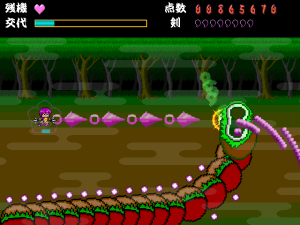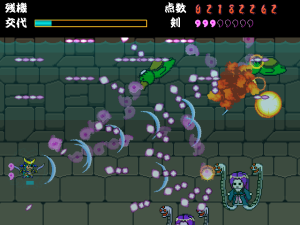Official(?) Download
NOTE: The official website no longer exists, credit goes to https://panchira.wordpress.com/ for containing a link.
NOTE 2: This game seems to be based on an anime called Sengoku Otome: Momoiro Paradox, which looks awful, but at least the game’s good!
I’m not sure as to exactly when I fell in love with the bullet hell subgenre, but I do know that I always enjoy stumbling across worthwhile entries and Sengoku Youkai Daikassen is one such entry. Taking place over the course of six stages (or ‘steges’ according to the in-game Engrish) in Warring States-era Japan, this horizontal shmup offers enough Continues to make it a good entry point for those new to the genre and enough nuance to its scoring system to satisfy most bullet hell veterans.
There is only one difficulty setting, but there are two teams to choose from, each with a female version of famous primary and secondary character from the era. Team A consists of Akechi Mitsuhide and Oda Nobunaga and Team B consists of Date Masamune and Toyotome Hideyoshi; Akechi and Date are the primary characters while Hideyoshi and Nobunaga are the secondary characters. You’ll be spending the majority of the game as one of the primary characters and, as is common amongst bullet hells, each of these characters has both a normal attack and a ‘focused’ attack which allows for slower, more precise movement. With a normal homing attack and a large focused attack, Date trades damage for accuracy while Akechi’s normal barrage of kunai and laser-like focused attack are a bit harder to hit with, but have higher destructive capabilities.

In addition to the differences between the characters themselves, normal and focused attacks create two different types of curved magatama jewels when they hit enemies. Normal attacks rapidly create pink jewels which serve to fill up a ‘jewel meter’ tied to the secondary characters, though this meter will reset if you lose a life. Focused attacks generate green jewels which fill up a ‘summon meter’ that determines how long your secondary character can stay out for and this meter does not reset upon death. The secondary characters themselves can be swapped to at any time with the push of a button as long as you have at least a little bit of the summon meter filled, though how they are used can vary greatly between players.
Secondary characters are more than just an alternative to a bomb system as they have quite a few interesting mechanics tied to them. Unlike primary characters, secondary characters only have a single, very strong attack; Nobunaga shoots big fireballs in a loose line while Hideyoshi sacrifices some horizontal range in exchange for a rapid-fire attack with a massive amount of vertical range. In addition to their raw strength, these attacks also generate large meter-filling pink jewels worth 100 points, ten times the value of the normal pink and green jewels. These characters are further aided by passively reducing the speed of nearby bullets and enemies to a crawl, though this can create a ‘wall of bullets’ effect which can be extremely dangerous if you are still on the wrong side of it when swapping back to your primary character. The summon meter rapidly drains while a secondary character is active and forcibly being swapped back to your primary character either from this meter running out or from taking a hit will cause both meters to fully deplete, but the true strength of these secondary characters lies in what happens when you willing swap back early.

I’ve mentioned the jewel meter a few times now, but I haven’t said much about what it actually does. This meter is tied to one-shot special attacks of Nobunaga and Hideyoshi and is the key both to dealing large amounts of damage and to getting a high score. The meter consists of eight jewels and for each jewel filled a weapon will appear behind your secondary character; Nobunaga gets swords and Hideyoshi gets spears, but the only difference I can notice between the two is in their appearance. These weapons do not normally aid in attacking, but they will grow in size and simultaneously be launched forward if you choose to swap back to your primary character before the summon meter depletes. Launching these projectiles while standing still or moving vertically will cause them to spread out, though they will stay largely grouped together if you swap while moving horizontally. Not only do these special attacks destroy any bullets they come into contact with, they generate coins from these bullets and any non-boss enemies they pierce through. On top of being useful for clearing out swarms of weak enemies, these weapons will get ‘stuck’ in stronger foes, rapidly dealing damage and generating coins either until the opponent is defeated or until the weapons eventually pass through. When and how you use the secondary characters and their finishing attacks may very well be the biggest factors in determining your survival capabilities and score in Sengoku Youkai Daikassen.
 Some bullet hells, especially those inspired by the Touhou series, focus almost entirely on the boss fights, but this one puts the spotlight on the stages themselves. There are dozens of enemies scattered between the stages, including at least one midboss per stage, and they are used together well to create challenging scenarios. Though the graphics are not exactly impressive, they do have a real sense of charm to them and go a long way towards giving the stages a sense of place. Your own character is free to go anywhere on the screen, but enemies are always positioned in ways which make sense – soldiers walk along the ground, ghosts fly through the air, ninjas run along walls, and so on. It sounds like a small and simple thing, but far too many games in this genre are happy enough to have enemies fly around everywhere above a bland or endlessly repeating background. As to the impact the graphics have on the gameplay itself, this is more of a mixed bag as on the one hand warning signs are always displayed well in advance for enemies coming from anywhere other than the right side while on the other hand the special attacks leave behind trails of cherry blossoms which can lead to some confusion as they make it difficult to see any remaining enemy bullets. The boss fights themselves are still the hardest parts of this game and nearly every boss summons in some sort of giant monster during the fight to mix things up, but the bullet patterns, while not bad, are neither particularly difficult nor visually impressive.
Some bullet hells, especially those inspired by the Touhou series, focus almost entirely on the boss fights, but this one puts the spotlight on the stages themselves. There are dozens of enemies scattered between the stages, including at least one midboss per stage, and they are used together well to create challenging scenarios. Though the graphics are not exactly impressive, they do have a real sense of charm to them and go a long way towards giving the stages a sense of place. Your own character is free to go anywhere on the screen, but enemies are always positioned in ways which make sense – soldiers walk along the ground, ghosts fly through the air, ninjas run along walls, and so on. It sounds like a small and simple thing, but far too many games in this genre are happy enough to have enemies fly around everywhere above a bland or endlessly repeating background. As to the impact the graphics have on the gameplay itself, this is more of a mixed bag as on the one hand warning signs are always displayed well in advance for enemies coming from anywhere other than the right side while on the other hand the special attacks leave behind trails of cherry blossoms which can lead to some confusion as they make it difficult to see any remaining enemy bullets. The boss fights themselves are still the hardest parts of this game and nearly every boss summons in some sort of giant monster during the fight to mix things up, but the bullet patterns, while not bad, are neither particularly difficult nor visually impressive.
Sengoku Youkai Daikassen is one of the easier bullet hells out there, but that does not at all make it a bad game. Both the presence of two teams to choose from and the mechanics tied around the team system itself go a long way towards combating the lack of multiple difficulties when it comes to replayability and the tools at the player’s disposal serve both to help inexperienced players to combat the swarms of bullets and to assist more seasoned players in chasing high scores. Though the boss fights are average, the stages themselves are impressive and the amateur graphics work in the game’s favor. Those who are more well-versed in the Warring States era of Japan and/or in Japanese mythology than I will likely particularly enjoy seeing the various characters, locations, and yokai, but this game is a fantastic choice both for existing fans of bullet hells and those interested in getting into the genre.